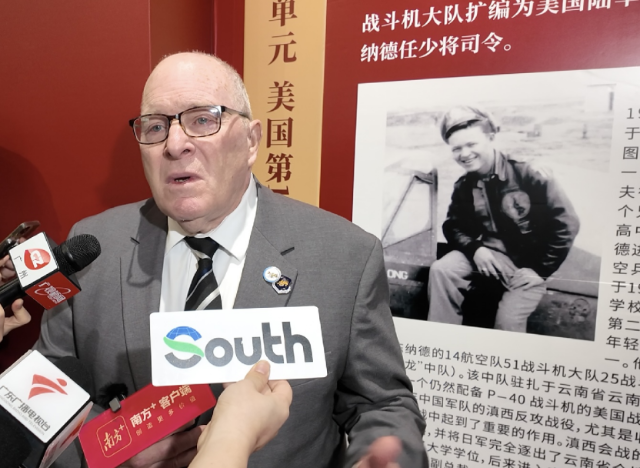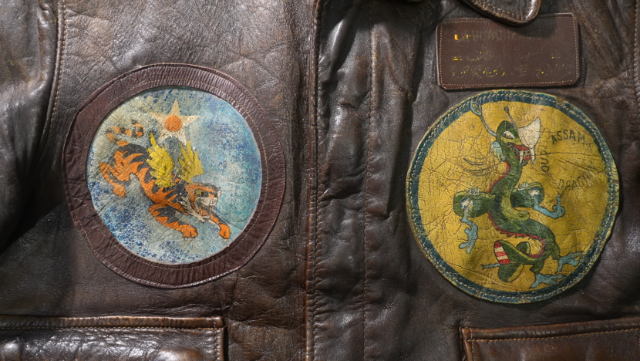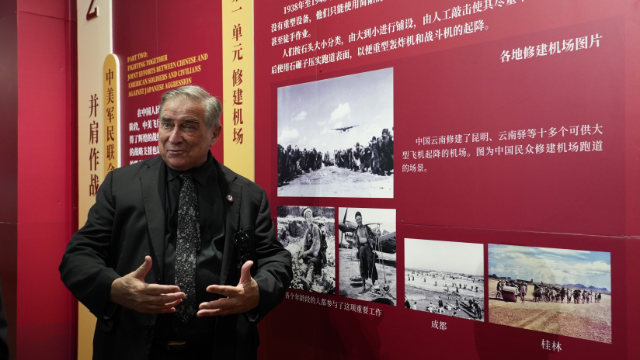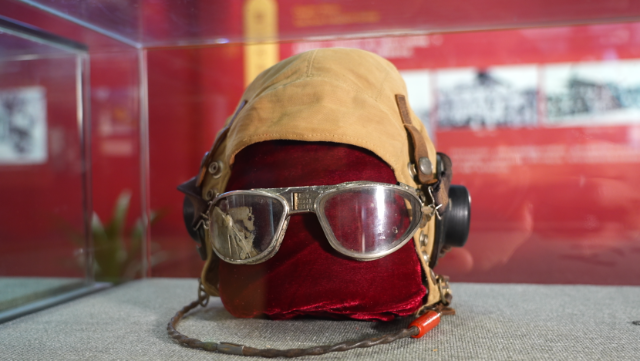"He would be overwhelmed with emotion. He would probably be crying as I am, but he would also be so excited to be among the Chinese people."
Standing beside the photo of his father, a pilot of the Flying Tigers, Clifford Ray Long, Vice Chairman of the Sino-American Aviation Heritage Foundation, answered South about how his father would feel if he were alive and could see the exhibition, tears welling up in his eyes.
A touching moment at exhibition

Standing next to his father's photo, Clifford Ray Long receives interviews at the exhibition in Guangzhou on July 3. (Photo: South)
This touching moment came at the "Remembering Heroes: The Flying Tigers" photo exhibition, which kicked off in Guangzhou on July 3.
The photo exhibition was co-hosted by the Guangdong People's Association for Friendship with Foreign Countries, the Sino-American Aviation Heritage Foundation and the Guangzhou People's Association for Friendship with Foreign Countries.
Clifford Ray Long introduced that his father was a 19-year-old young man when he came to China, the youngest pilot in 1944 in China. The Chinese called him Lieutenant Moon because he had a round face.
Clifford highlighted two of his father's missions among the 104 he completed in the Flying Tigers. One of the most important missions was the rocket attack on Tengchong, an ancient city in China's Yunnan Province, which the Japanese had taken over prior to the attack.
"My father was selected for that mission because he was a very skilled bomber pilot. It was crucial to get the Japanese out of the city. That attack helped the Chinese soldiers to overrun the city and take it back," he added.
"Although it was war and it wasn't pretty, he came home with a love for the Chinese people, and that stayed with him his whole life," said the descendant of the Flying Tigers.
The origin of Flying Tigers logo

Logo of Flying Tigers in the uniform in Guangzhou on July 3. (Photo: South)
One might not know that the prestigious Flying Tigers logo came from a Chinese overseas painter, Zhang Shanzi, as Lin Gan, President of the Guangzhou Society of Overseas Chinese History, told South.
When he heard that Claire Lee Chennault was going to form a civilian volunteer team to aid China, Zhang drew two tigers with wings and gave them to Chennault as a gift.
"This painting is called Flying Tiger. Later, Chennault used the title Flying Tigers as the name of the American Volunteer Group, nicknamed Flying Tigers," Lin detailed.
According to him, this incident also shows that overseas Chinese have a very close connection with the Flying Tigers.
Unsung heroes fighting in WWII

Jeffrey Greene introduces Chinese people's efforts to build American airfields in Guangzhou on July 3. (Photo: South)
"I've brought about 500 Flying Tiger pilots back to China in the last 30 years, and I've heard their stories," noted Jeffrey Greene, Chairman of the Sino-American Aviation Heritage Foundation.
Recalling some American veterans who fought in Guangdong, he touched on a guerrilla group based in Guangdong—the East River Column.
As Hong Kong was a very important target for American pilots, Japanese supplies came into Hong Kong from Japan to southern China.
According to Greene, at least ten pilots were rescued by the East River Column and kept safe from the Japanese, which was very difficult to accomplish. The Japanese found a Chinese person who was helping an American and killed him immediately. Generally, they would kill his family as well.
Greene lauded the significant effort made by the Guangdong group to connect with other guerrilla groups further to the west, allowing them to return to the Chinese army and the American air forces.
"These guerrillas did a very brave job. They played a crucial role in getting these Americans back into the war," he added.

A helmet with a pair of glasses worn by Flying Tiger pilots in Guangzhou on July 3. (Photo: South)
Above all, the Chairman of the Sino-American Aviation Heritage Foundation underscored the tremendous alliance between China and the US during the Second World War.
"The role played by the Chinese in supporting the American pilots cannot be forgotten. And also, the role the American pilots played in stopping the Japanese from bombing the cities of your grandparents and great-grandparents," he told the young Chinese reporters.
Unfortunately, as Greene observes, this history does not receive coverage in the West, in Europe, or in the United States. He urged more people today to commemorate those forgotten heroes, both from China and the US.
Reporter: Zhang Ruijun
Video & Poster: Guo Hongda
Script: Zhang Ruijun
Cameraman: Guo Hongda
Editor: Yuan Zixiang, James, Shen He
















